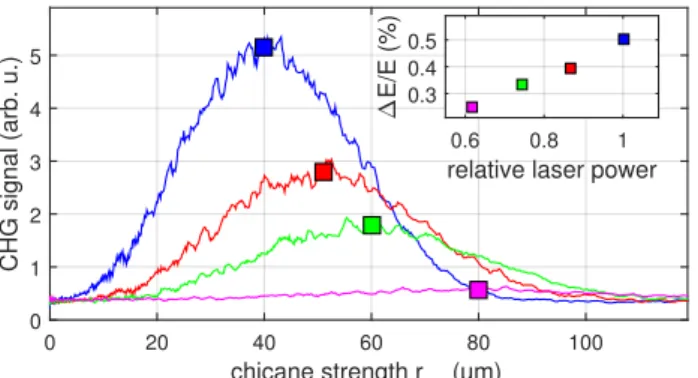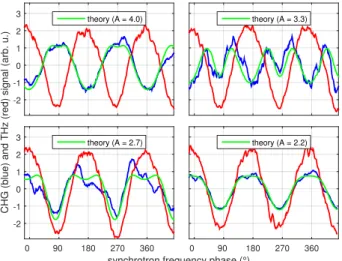MEASUREMENT OF THE LASER-INDUCED ENERGY MODULATION AMPLITUDE AT THE SHORT-PULSE FACILITY AT DELTA
∗A. Meyer auf der Heide†, B. Büsing, S. Khan, N. M. Lockmann, C. Mai, B. Riemann, B. Sawadski TU Dortmund University, Dortmund, Germany
Abstract
The short-pulse facility at the synchrotron light source DELTA operated by the TU Dortmund University employs coherent harmonic generation (CHG) to provide ultrashort pulses in the vacuum ultraviolet and terahertz regime. Here, a laser-electron interaction results in a modulation of the electron energy which is transformed into a density modu- lation by a magnetic chicane. Measurements of the energy modulation amplitude with different techniques including an RF phase modulation are presented. A combination of the results allow to estimate the energy spread of the electron beam.
INTRODUCTION
The short-pulse facility at the 1.5-GeV synchrotron light source DELTA operated by the TU Dortmund University produces ultrashort light pulses in the visible and vacuum ul- traviolet (VUV) regime by employing the coherent harmonic generation (CHG) technique [1]. Based on an interaction of a femtosecond laser pulse with a single electron bunch, a sinusoidal modulation of the electron energy results in the coherent emission of synchrotron radiation pulses at har- monics of the laser wavelength while preserving the pulse duration of the laser pulse.
In the CHG scheme (see Fig. 1, top), an interaction of an electron bunch in an undulator (’modulator’) with a co- propagating laser pulse leads to a sinusoidal modulation of the electron energyEwith an amplitude∆E. Subsequently, the energy-dependent path length differences
∆z=r56∆E
E (1)
in a magnetic chicane with strengthr56transforms the en- ergy modulation into periodic microbunches at intervals of the laser wavelengthλL. The degree of microbunching is described by the so-called bunching factor [2]
bn =e−12n2B2
·Jn(n·A·B), (2) with
A=∆E σE
and B=r56·2π λL
·σE
E .
Here,nis the harmonic number,Jn is the bessel function of the order ofn, andσEis the natural energy spread of the electron bunch. With a properly set chicane strengthr56, the
∗Work supported by the BMBF (05K16PEA, 05K16PEB), MERCUR (Pr-2014-0047) and the state of NRW.
†arne.meyeraufderheide@tu-dortmund.de
before after
modulation chicane chicane
chicane
modulator r adiator
modulator
modulator r adiator
ΔE/(%)
z /l laser
laser laser
z /l
z /l z /l
z /l ρ/ρ0ρ/ρ0
a) CHG
b) EEHG
E
ΔE/(%)E
Figure 1: Magnetic setups for CHG (a) and EEHG (b), cor- responding longitudinal phase space distributions and the final longitudinal charge density.
bunching factor is maximized and can be described by [3]
bn≈0.68 n1/3 exp
− n2 2A2
. (3)
In the following undulator (’radiator’), the microbunches give rise to coherent emission of synchrotron radiation at harmonics of the laser wavelength with an emitted power
Pcoh∝N2·b2n· (4) scaling quadratically with the number of electronsN. Since only electrons interacting with the laser pulse contribute to the bunching factor, the duration of the coherently emitted pulses is of the order of the laser pulse duration and, thus, in the tens of femtosecond range.
Further downstream, the energy-modulated electrons leave their original position within the electron bunch due to energy-dependent path length differences in the following dipoles, thereby forming a dip in the longitudinal electron density. This dip with a width in the sub-ps range gives rise to coherent emission of THz radiation pulses.
As given in Eq. (3), the bunching factor scales withe−n2 which practically limits the CHG scheme to aboutn=5. In 2009, the more sophisticated technique echo-enabled har- monic generation (EEHG) [4] was proposed (see Fig. 1,
9th International Particle Accelerator Conference IPAC2018, Vancouver, BC, Canada JACoW Publishing
ISBN:978-3-95450-184-7 doi:10.18429/JACoW-IPAC2018-THPMK099
THPMK099 4538
ContentfromthisworkmaybeusedunderthetermsoftheCCBY3.0licence(©2018).Anydistributionofthisworkmustmaintainattributiontotheauthor(s),titleofthework,publisher,andDOI.
02 Photon Sources and Electron Accelerators A05 Synchrotron Radiation Facilities
bottom). Here, another modulator is added upstream of the CHG setup in which another laser-electron interaction takes place followed by a strong chicane. This results in a longitudinal electron distribution which allows for coherent emission at much higher harmonics as the bunching fac- tor, here, scales withn−1/3. Preparations for a modification of the short-pulse facility towards employing EEHG are in progress [5].
THE SHORT-PULSE FACILITY AT DELTA
Figure 2: The short-pulse facility in the northern part of DELTA comprises a laser laboratory, the seeding beamline BL 3, the electromagnetic undulator U250, the diagnostics beamline BL 4, the VUV beamline BL 5, and the THz beam- line BL 5a.
In 2011, the CHG scheme was implemented at the DELTA storage ring to generate ultrashort coherent synchrotron radi- ation pulses in the VUV regime [6,7]. In a laser laboratory, a titanium:sapphire laser system provides 800-nm seed pulses at a repetition rate of 1 kHz and up to 8 mJ pulse energy, which are focused and guided into the storage ring via beam- line 3 (BL 3, see Fig. 2). The modulator, chicane and radiator are realized by dividing the undulator U250 into three in- dependently powered sections. For diagnostics purposes, both, synchrotron radiation and laser pulses are guided via beamline BL 4 to a hutch equipped with screens, photodi- odes and a streak camera used to establish the transverse and longitudinal overlap of the electron bunch and the laser pulse and, thus, to enable the emission of CHG pulses. For the characterization of CHG radiation see e.g. [8, 9].
chicane strength r56 (µm)
0 20 40 60 80 100
CHG signal (arb. u.)
0 1 2 3 4 5
relative laser power
0.6 0.8 1
"E/E (%) 0.3 0.4 0.5
Figure 3: CHG signal versus chicane strengthr56for differ- ent laser pulse energies. Squares: Maximum signal. Top right: Corresponding relative modulation amplitudes∆E/E for different laser pulse energies.
Pump-probe experiments using the ultrashort CHG pulses as probe pulse can be performed at the soft-X-ray beamline (BL 5). A fraction of the laser pulse with adjustable delay is directly guided to the experiment and is used as a pump pulse. A first demonstration of a pump-probe experiment was presented in [10].
The laser-induced THz radiation is picked up at a bending magnet using a dedicated THz beamline (BL 5a) and gives the first indication for a successful laser-electron overlap.
Furthermore, several experiments utilizing the THz radiation were carried out (e.g. [11]).
EXPERIMENTAL RESULTS
Measuring the Energy Modulation Amplitude
For a certain energy modulation amplitude, the bunching factor given in Eq. (2) follows a Bessel function and reaches an optimum at a certain chicane strengthr56.
In Fig. 3, CHG signals while continuously increasing the chicane strength are shown for different laser pulse ener- gies and, thus, different modulation amplitudes. With the argument of the Bessel function depending on∆E/E, the maxima of each curve allow to determine energy modulation amplitudes∆E/Eof up to 0.5% which are shown in the top right plot of Fig. 3.
CHG in the Presence of an RF Phase Modulation
In standard user operation at DELTA, a routinely applied phase modulation of the accelerating RF results in a decrease of the average electron density while increasing the beam lifetime [12]. In CHG operation, this would decrease the achievable signal.
However, different parameters of the RF phase modula- tion enables the formation of two stable islands rotating in the longitudinal phase space. Depending on the phase modu- lation amplitude, this results in either a periodic lengthening of the electron bunches (see Fig. 4, center), or the formation of two separate islands (Fig. 4, right).
In the regime of periodic lengthening, phases with longer bunch duration correspond to a reduced energy spread and vice versa. By introducing a factor s which transforms σE →σE/sand, thus,A→s·A, andN →N/ssince both energy spread and bunch length and, thus, number of elec- trons interacting with the laser pulse are affected by the RF phase modulation, Eq. (3) transforms into
Pcoh∝ 1
sn1/3 exp
− n2 2s2A2
2
. (5)
Evaluating this formula for the third harmonic (n = 3) with different modulation amplitudesAyields the plot shown in Fig. 5. For largeA, the emitted power is largest at phases with a smallswhich corresponds to a larger electron density but also a larger energy spread. For smaller amplitudes, the behavior reverses. Here, a small energy spread is required instead. The THz signal, however, does not change its be- havior, as it mainly requires a small energy spread. This also
9th International Particle Accelerator Conference IPAC2018, Vancouver, BC, Canada JACoW Publishing
ISBN:978-3-95450-184-7 doi:10.18429/JACoW-IPAC2018-THPMK099
02 Photon Sources and Electron Accelerators A05 Synchrotron Radiation Facilities
THPMK099 4539
ContentfromthisworkmaybeusedunderthetermsoftheCCBY3.0licence(©2018).Anydistributionofthisworkmustmaintainattributiontotheauthor(s),titleofthework,publisher,andDOI.
Figure 4: Streak camera images showing the evolution of the longitudinal bunch profile (horizontal axis) over 1.5 syn- chrotron periods (vertical axis) without RF phase modula- tion (left) and with RF phase modulation with increasing amplitude (center and right).
means that the THz and CHG signals are opposite in phase at large amplitudes and in-phase for smaller A(see Fig. 6 and also [13]).
In the intermediate region between large and small modu- lation amplitudes, for example at A=3.3 (see Fig. 6), the CHG signals tends to oscillate twice as often. Here, a com- bination of reduced electron density but also reduced energy spread appears to be better than either a minimum energy spread or a maximum electron density.
Combining the measurement of the modulation amplitude
∆E/Eby scanning the chicane strengthr56(see Fig. 3) with the determination ofAas proposed here allows to estimate the energy spreadσEof the electron beam.
In Fig. 6, the laser-induced THz and third-harmonic CHG signals are shown together with theoretical curves from Fig. 5. The modulation amplitudes correspond to those shown in Fig. 3. As expected, the signals are opposite in phase at a large energy modulation amplitude and being
energy modulation amplitude A
1 1.5 2 2.5 3 3.5 4 4.5 5
time / synchrotron period
1
1/2
0
CHG power (arb. u.)
0.1 0.2 0.3 0.4 0.5 0.6 0.7 0.8 0.9
Figure 5: Normalized CHG power as function of the en- ergy modulation amplitudeAand time whiles(see Eq. (5)) oscillates twice per synchrotron period due to RF phase modulation. Here,soscillates between 0.7 and 1.3 and is smallest at t = 0. Curves used in Fig. 6 are indicated in green.
-2 -1 0 1 2
3 theory (A = 4.0) theory (A = 3.3)
0 90 180 270 360
CHG (blue) and THz (red) signal (arb. u.)
-2 -1 0 1 2
3 theory (A = 2.7)
synchrotron frequency phase (°)
0 90 180 270 360
theory (A = 2.2)
Figure 6: Laser-induced THz (red) and CHG (blue) signals (mean values subtracted) under the influence of an RF phase modulation versus the synchrotron frequency phase and the- oretical CHG signals (green, from Fig. 5) for different energy modulation amplitudes A.
in-phase for a small amplitude. The two measurements in the intermediate regime with amplitudes of aboutA=3.3 and A=2.7 correspond to values of∆E/E =0.39% and
∆E/E = 0.33%, both resulting in an estimated energy spread ofσE/E≈1.2·10−3.
CONCLUSION AND OUTLOOK
With the implementation of CHG at DELTA, a modulation of the electron energy due to a laser-electron interaction allows the coherent emission of synchrotron radiation pulses at harmonics of the laser wavelength while maintaining the duration of the laser pulse. Measuring the energy modulation amplitudes∆E/Eand, using RF phase modulation,∆E/σE
allow to estimate the energy spreadσEof the electron beam.
A first result ofσE/E =1.2·10−3is almost twice as high as the natural energy spread of 7·10−4according to the design lattice. A possible influence of the RF phase modulation on the energy spread requires further investigations.
In any case, the method will allow to detect changes of the energy spread caused, e.g., by insertion devices or collective effects.
ACKNOWLEDGMENT
We are pleased to thank our colleagues at DELTA and the TU Dortmund University. The continuous support from other institutes, particularly from DESY Hamburg, HZB Berlin, and KIT Karlsruhe is gratefully acknowledged.
9th International Particle Accelerator Conference IPAC2018, Vancouver, BC, Canada JACoW Publishing
ISBN:978-3-95450-184-7 doi:10.18429/JACoW-IPAC2018-THPMK099
THPMK099 4540
ContentfromthisworkmaybeusedunderthetermsoftheCCBY3.0licence(©2018).Anydistributionofthisworkmustmaintainattributiontotheauthor(s),titleofthework,publisher,andDOI.
02 Photon Sources and Electron Accelerators A05 Synchrotron Radiation Facilities
REFERENCES
[1] R. Coisson and F. De Martini, "Free-electron coherent rela- tivistic scatterer for UV-generation", inPhysics of Quantum Electronics, vol. 9, S. F. Jacobset al., Ed. Boston, MA, USA:
Addison Wesley, 1982.
[2] L. H. Yu, "Generation of intense uv radiation by subharmon- ically seeded single-pass free-electron lasers",Phys. Rev. A, vol. 44, no. 8, pp. 5178-5193, 1991.
[3] G. Stupakov, "Beam Echo Effect for Generation of Short- Wavelength Radiation", inProc. 31st Free Electron Laser Conf.
(FEL’09), Liverpool, United Kingdom, 2009, pp. 15-22.
[4] G. Stupakov, "Using the Beam-Echo Effect for Generation of Short-Wavelength Radiation",Phys. Rev. Lett., vol. 102, no. 7, p. 074801, 2009.
[5] A. Meyer auf der Heideet al., "Progress Towards an EEHG- Based Short-Pulse Source at DELTA", inProc. 8th Int. Particle Accelerator Conf. (IPAC’17), Copenhagen, Denmark, 2017, pp. 2582-2585.
[6] S. Khanet al., "Coherent Harmonic Generation at DELTA:
A New Facility for Ultrashort Pulses in the VUV and THz Regime",Sync. Radiat. News, vol. 24, no. 5, pp. 18-23, 2011.
[7] S. Khanet al., "Generation of Ultrashort and Coherent Syn- chrotron Radiation Pulses at DELTA",Sync. Radiat. News, vol 26, no. 3, pp. 25-29, 2013.
[8] M. Hucket al., "Ultrashort and Coherent Radiation for Pump- Probe Experiments at the DELTA Storage Ring", inProc. 5th Int. Particle Accelerator Conf. (IPAC’14), Dresden, Germany, 2014, p. 1848-1851.
[9] S. Khanet al., "Spectral Studies of Ultrashort and Coherent Radiation Pulses at the DELTA Storage Ring", inProc. 7th Int.
Particle Accelerator Conf. (IPAC’16), Busan, Corea, 2016, p.
2851-2854.
[10] S. Khanet al., "Pilot Experiments and new Developments at the DELTA Short-Pulse Facility", inProc. 8th Int. Particle Accelerator Conf. (IPAC’17), Copenhagen, Denmark, 2017, pp. 2578-2581.
[11] C. Maiet al., "A Tunable Narrowband Source in the Sub-THz and THz Range at DELTA", presented at the 9th Int. Particle Accelerator Conf. (IPAC’18), Vancouver, Canada, 2018, paper THPMK098, this conference.
[12] M. A. Jebramciket al., "Coherent Harmonic Generation in the Presence of Synchronized RF Phase Modulation at DELTA", inProc. 7th Int. Particle Accelerator Conf. (IPAC’16), Busan, Corea, 2016, pp. 2847-2850.
[13] A. Meyer auf der Heideet al., "Coherent Harmonic Genera- tion at the DELTA Storage Ring: Towards User Operation", inProc. 36th Int. Free Electron Laser Conf. (FEL’14), Basel, Switzerland, 2014, pp. 556-560.
9th International Particle Accelerator Conference IPAC2018, Vancouver, BC, Canada JACoW Publishing
ISBN:978-3-95450-184-7 doi:10.18429/JACoW-IPAC2018-THPMK099
02 Photon Sources and Electron Accelerators A05 Synchrotron Radiation Facilities
THPMK099 4541
ContentfromthisworkmaybeusedunderthetermsoftheCCBY3.0licence(©2018).Anydistributionofthisworkmustmaintainattributiontotheauthor(s),titleofthework,publisher,andDOI.


